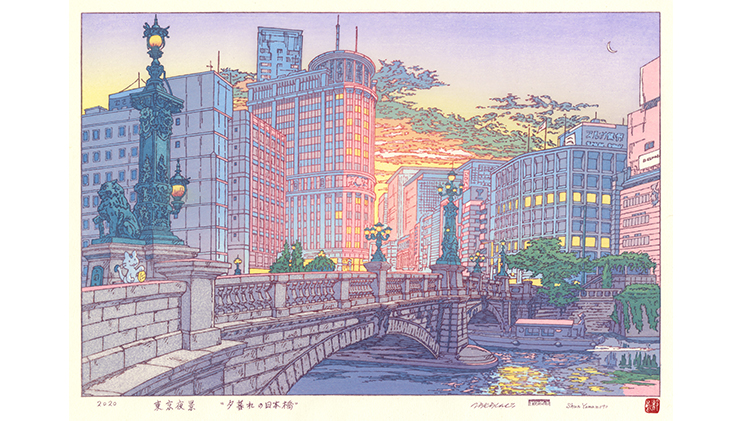Sudden Large-scale “Coat of Arms” Laser Show on the Street, Collision of Creators’ Inspirations from Different Fields, and Emergence of Installation Works of Art
Sudden Large-scale “Coat of Arms” Laser Show on the Street, Collision of Creators’ Inspirations from Different Fields, and Emergence of Installation Works of Art

“NIHONBASHI MEGURU FES” is on the stage subject to the theme of “Cooperation to Upgrade the Assets of Nihonbashi”, where visitors have a chance to appreciate different content, of which, the major one, Installation Works “Coat of Arms -Mon Terrace-” is to be held at the COREDO Muromachi Terrace from Oct. 22 (Tuesday) to Oct. 31 (Thursday).
All works are expressed in new ways, such as laser and projection, on the basis of “Coat of Arms”, a traditional expression form in Japan, to cause it sparking new charms. For the cooperation, an interview was done with Mr. Shoryu Hatoba and Mr. Youji Hatoba, 2 top painters of coats of arms, Ms. Kanae Tanikawa and Mr. Ken Arai (from the Art Team MES) responsible for the laser effects, and Mr. Michiyasu Wada (from Bascule Inc.), the chief commander, who expressed their opinion that “there are many common points between coat of arms and laser”. During the interview, the author learned their stories of creation, including the trial-and-error and manufacturing processes bringing the works into reality.
Origin of creativity: improve performance effects with laser
-First, I shall briefly introduce you the planning scheme.
Mr. Michiyasu Wada (hereinafter referred to as Wada): The Installation Works “Coat of Arms -Mon Terrace-” combined the coat of arms and laser, 2 seemingly contrary elements. It is an attempt of upgrading traditional expression forms through technical means. This piece of works is based on several coats of arms created by Mr. Hatoba, and showed with the laser technology developed by MES to achieve the combination of lights and shadows. In front of the main entrance to the COREDO Muromachi Terrace, the works is projected onto a screen of 9m wide and 3m high, which is also used as a large quilted door curtain, in order to endow the works with high appreciation values and entertainment.

Mr. Michiyasu Wada, an engineer and technical director of Bascule Inc.
—You intended to combine the coat of arms with laser from the very beginning?
Wada: No, it came out on the half way during our preparation for another activity “the Tour Exhibition of Quilted Door Curtains” when Mr. Hatoba was entrusted to make a very beautiful quilted door curtain with “kylin” as the coat of arms. The idea we held from the very beginning is to transform the works into an installation on this basis. But how to show the coat of arms, and if new expression forms shall be adopted, we had no absolute answers, and laser was selected after repeated thinking for a while.
Mr. Shoryu Hatoba (hereinafter referred to as Shoryu): We participated in the whole process from the initial planning stage, and had various creations in such a process.
—What’s the creativity you firstly discussed?
Shoryu: As a top painter of coats of arms, I originally worked manually. 10 years ago, I changed my job to a designer of coat of arms with Illustrator. No matter which means is adopted, manual painting or digital dependence, the coat of arms could only be expressed with circles and straight lines. That never changes. Therefore, preliminarily we focused on the “circle” of the coat of arms with an intention to use it as the core of the installation works of art.
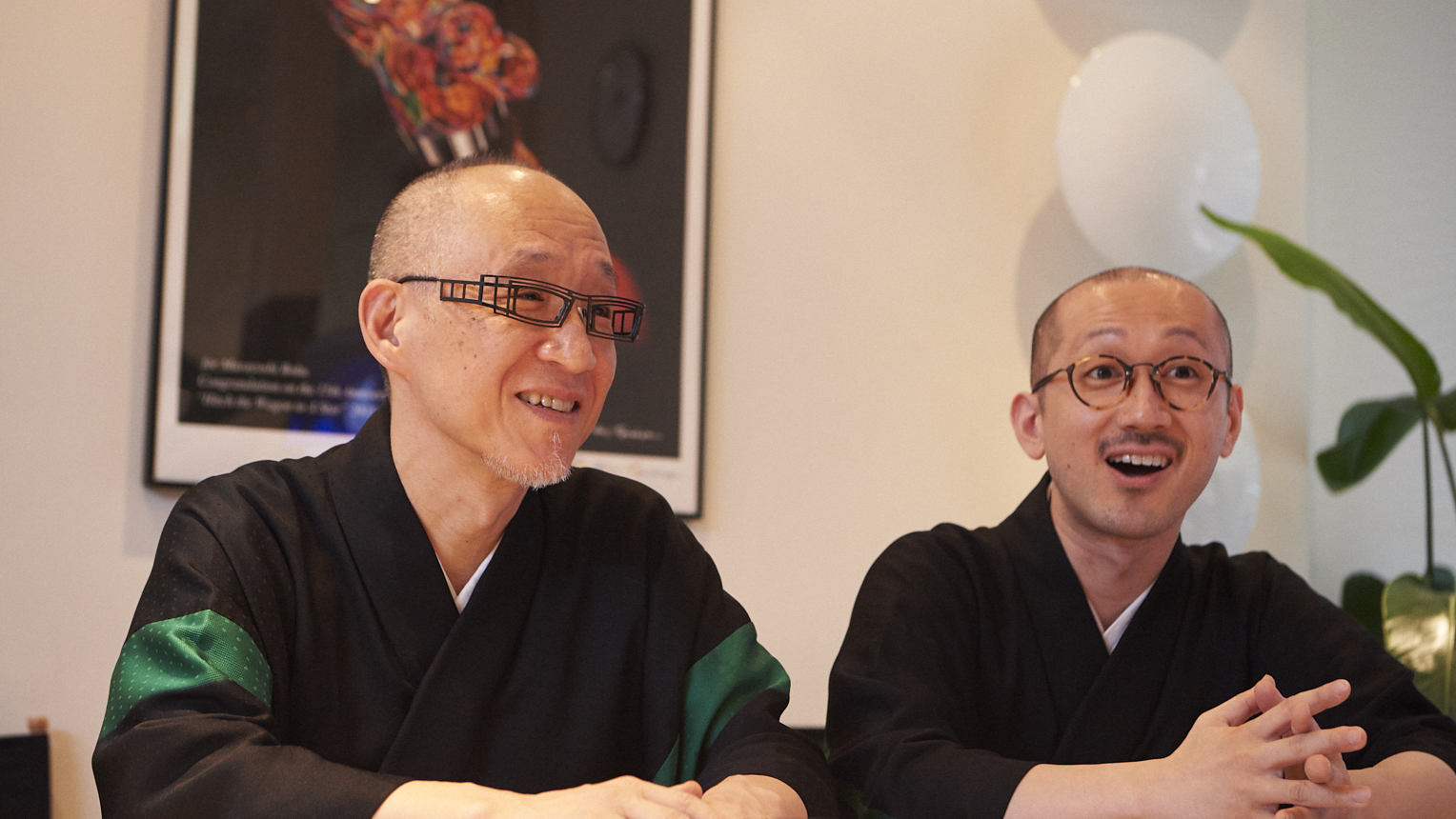
Mr. Shoryu Hatoba (left) and Mr. Youji Hatoba (right), top painters of coats of arms
Wada: Yeah. The most interesting link in the formation of a coat of arms by Mr. Hatoba is the manufacturing, during which, a unique expression form of “Coat of Arms Mandara” is adopted, using the orbits of numerous circles to form the works. With the original intention to show the process from circles to a coat of arms by overlapping, the orbits of circles were based on to show the works at the very beginning.
The initial plan was interactive and it is a channel to see that a coat of arms is formed by a number of circles so that visitors would be encouraged to make circles and then a coat of arms on the site in person. The principle is detecting and analyzing visitors’ actions with the waist through a sensor, and making circles on the screen according to the moving trajectory. The coats of arms produced vary according to the methods of making a circle or the number of circles.
diagram of initial plan
Furthermore, if we move only with the waists, the effect can be sensed easily. To achieve the harmony between our actions and the sounds of Taiko or the tinkle of bells, so that visitors can have a touching feeling of making a coat of arms, we upgraded the versions and made many detailed improvements.
—If a turning point showed up during your transformation from such a plan to the combination with laser?
Wada: In fast, there were two problems which we found an answer in the process of solution with Laser.
The first question is the NHK popular program “Design”. It has a special part for “coats of arms” participated by Mr. Hatoba with his works. As the program is very famous and highly accomplished, when we were trying to express our coats of arms, the train of thought in the program often led us (laughing). The program exhibits the “completion process of a coat of arms” by shadows. If we focus on the combination of circles for works creation, it would be quite similar to the expression form of “Design”. Therefore, we have to find a new sally port.
Another question is the exhibition site. Though it is quite eye attracting as we have selected the square in front of the COREDO Muromachi Terrace, visitors have to leave the main road and go inside further. It is not a place easily to be found. Therefore, we changed to another performance form. Visitors may stand at a further place to appreciate the installation works here. On this basis, lights were integrated, and therefrom the idea of “laser better than light” rose.
Exhibition of coats of arms with laser is an impactful means. Given such a rare chance, we should adopt new methods. Therefore, the study on the laser cases began.
In such a process, a video recording the performance in the Disneyland California drew our attention. The actor sometimes folded the laser lights or held it in hand with flexible operations just like our vision. The synchronization between the actor and the laser is so surprising and inspiring. We hope everyone who has watched the works can produce the same feeling. Therefore, the coats of arms were designated as the actors to synchronize with the laser, so as to reproduce the correlation between the 2 items.
Reproduction of the “changes” to coats of arms based on the works
—Then we contacted the 2 artists from MES. What’s your job in ordinary time?
Ms. Kanae Tanikawa (hereinafter referred to as Tanikawa): We teamed up in 2015 when both of us were studying in Tokyo University of the Arts. Later, we worked for Visual Jockey, VG with the laser artworks of Arai. This is the turning point of our cooperation at other premises in addition to exhibitions with laser works. Later, expansion was realized on the basis of VG, and more chances were sourced from the fashion and entertainment field. Now the major expression forms adopted include laser, sculpturing and installation.
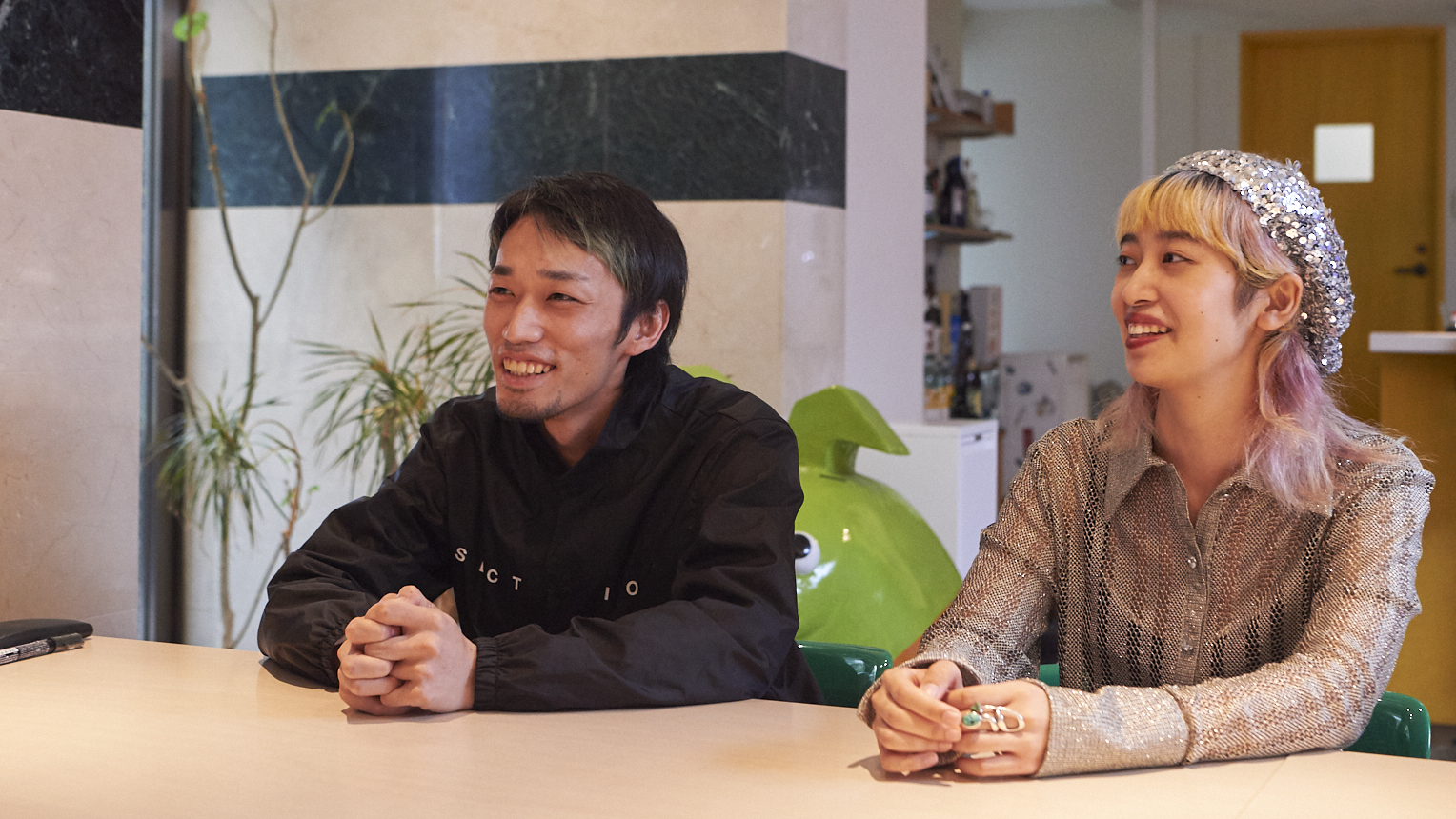
Mr. Ken Arai (left) and Ms. Kanae Tanikawa (right) from MES
Wada: Speaking of laser, we often think of the laser lights used on the site. The 2 artists from MES have developed unique methods using the tip of laser for painting in addition to the light. Therefore, detailed expression is achieved through the synchronization of coats of arms and laser. The 2 artists are the best candidates of the task.
—What is the process to accomplish the works as you have all the members you want in the producing team?
Wada: The general process is as follows.
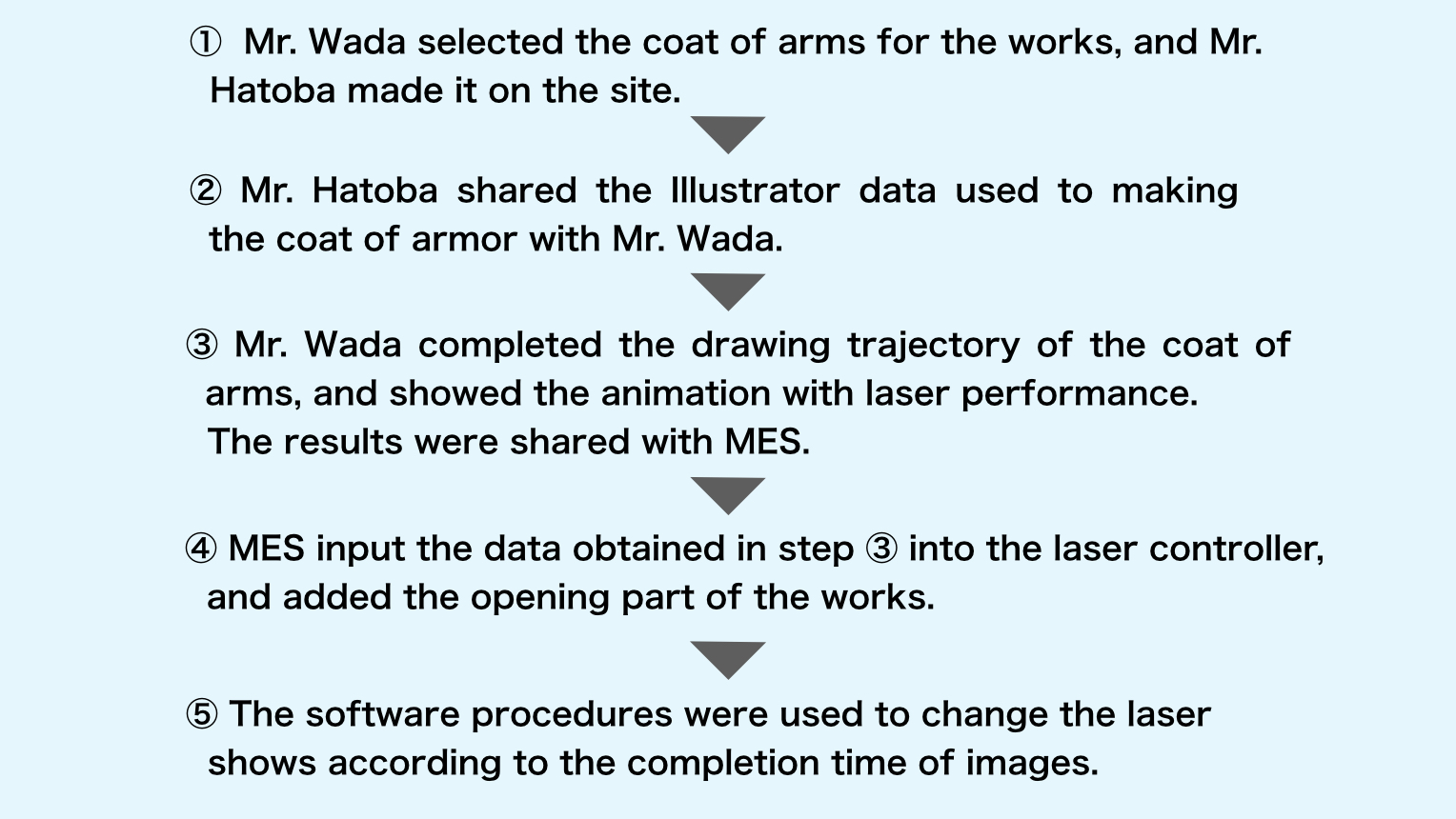
Shoryu: The coats of arms selected in step ① were after deliberate consideration, and a combination of numerous patterns from the book of coats of arms (including the collection of thousands of family coats of arms).
Wada: We were totally lost at the beginning with little knowledge on coats of arms. We didn’t know which one fits for the show. That’s a really a headache then (laughing). But after leafing through the book of coats of arms, we found something unique and interesting. In addition to basic patterns such as animals, plants and tools, there were some coats of arms consisting of a number of similar or different patterns. The most interesting part is that some coats of arms seem to have simulated different patterns.
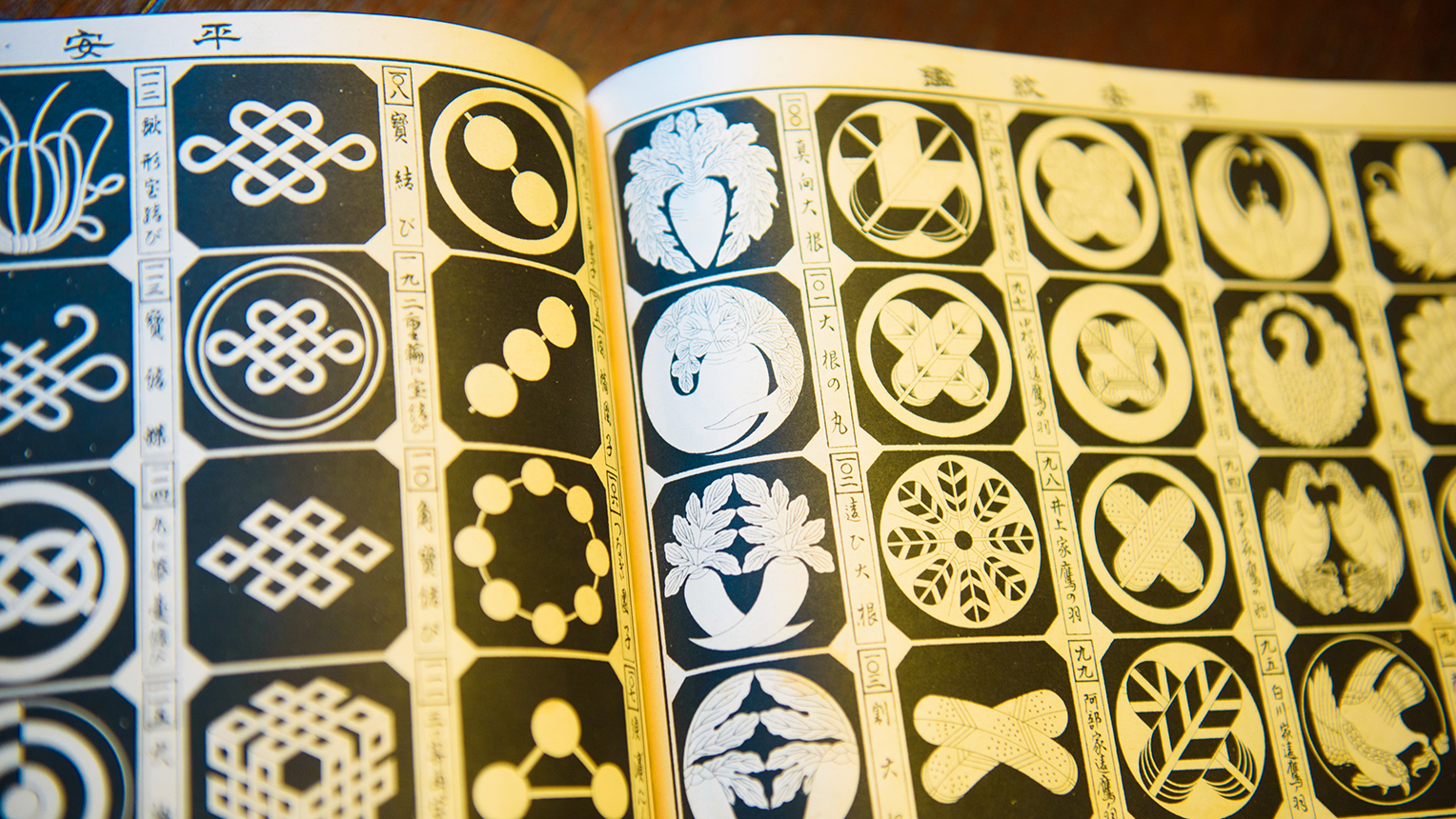
Some patterns in the book of coats of arms. A pattern with various changes
Shoryu: This is the Jianli coat of arms developed in the Edo period. As ordinary people were not allowed to use the same coats of arms as those at higher ranks. Therefore, different ones were combined to form a new one which looks right, but in fact wrong. Such coats of arms developed by civilians were somehow mimic, and typical cases of creating new things from the bugs of rules. That’s the interesting part of coats of arms.
Wada: Those coats of arms came from limitations, and we hope to show you their interests. When selecting the coats of arms, we paid attention to 2 points: “pure interests from the perspective of painting” and “with changes on the basis of Jianli coats of arms”.
—How did you conceptualize the works after selecting the coats of arms? For example, using laser at a certain point or according to a certain process.
Wada: As just the Disneyland show we have mentioned before, we intended to have a works combining coats of arms with lasers for mutual effects. Therefore, we believed that it would be much funny if the laser is used as a “trigger of changes” in the processes of changing coats of arms, to achieve the performance effects. Besides, this would distinguish us from the “Design”. If the funs of “Design” lie in the introduction of making a coat of arm, then we are showing its changes, which exhibit the charms of coats of arms from a perspective totally different from “Design”.
—Laser shows up at the critical moment of changing “coats of arms”.
Wada: Indeed. For example, the Goose pattern we adopted in this works. Originally there was only one, which then changed to 3 and 8. With increasing number of geese, different coats of arms were formed. We considered exhibiting the changing process of coats of arms with increasing number of geese, but spaces shall be reserved for this purpose by removing the original goose. But, it would be strange if the one is removed without a reason. Therefore, to find an excuse for the removal of the goose, we changed the process that the goose flew away when being targeted by the laser, and changed into another humorous animation (laughing). That’s to say, a relationship was established in the context, and laser made the story true.
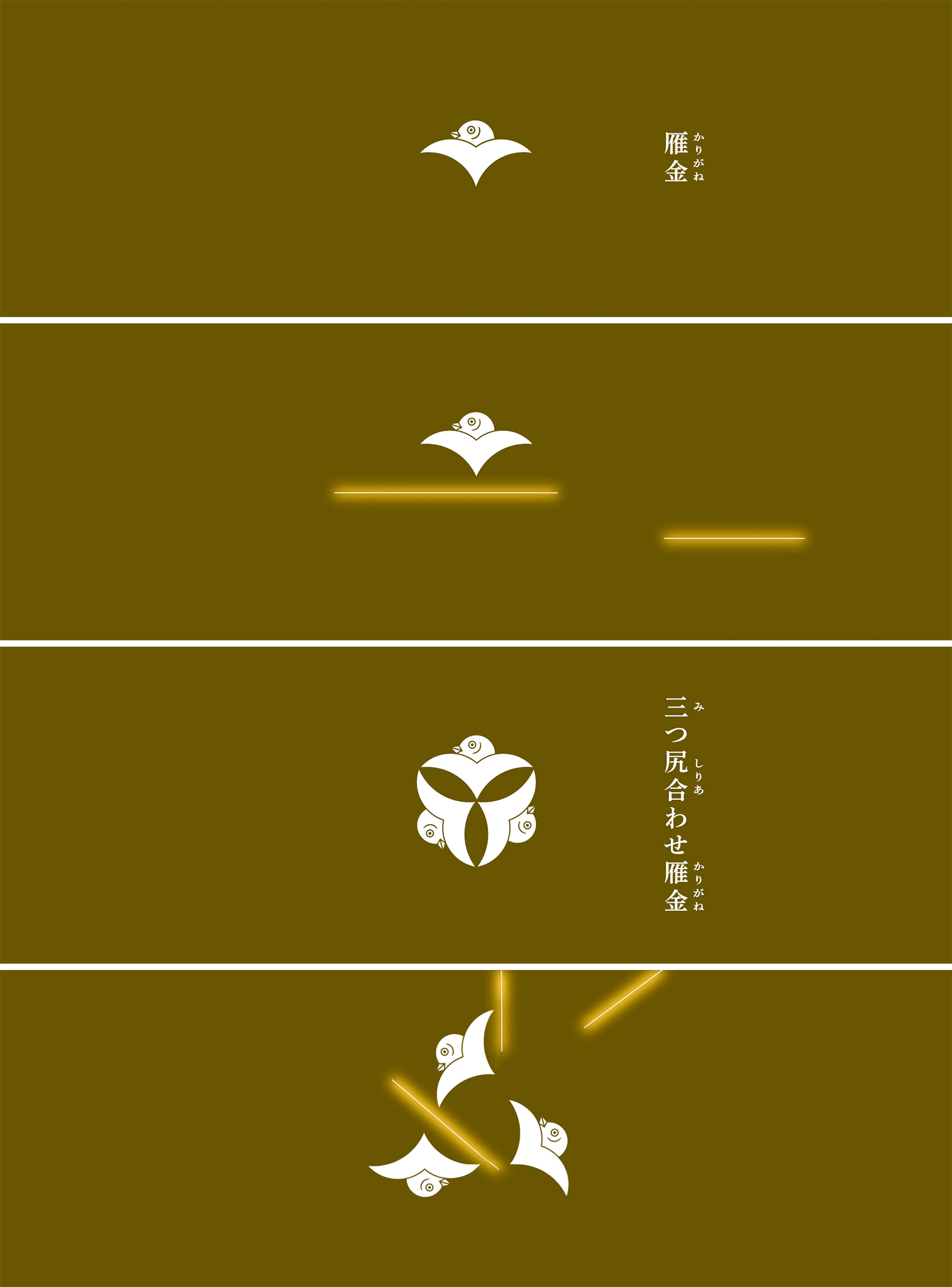
changing process of the goose pattern
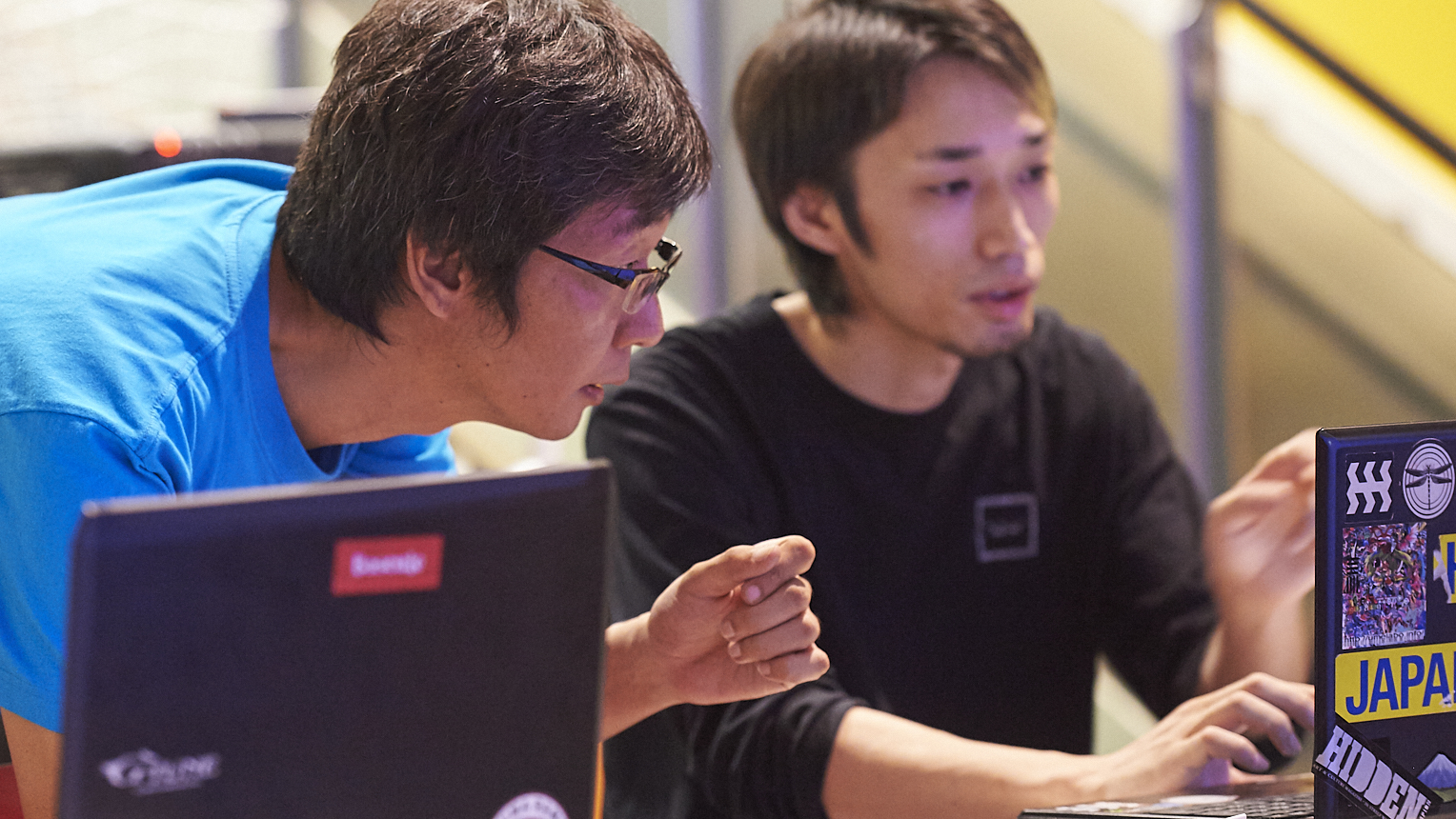

Careful confirmation to achieve the perfect synchronization of animation and laser
The common point between the 2 is “Over the Limit”
-MES must have cooperated with talents form different fields before, but seldom with the coats of arms, a traditional expression form?
Tanikawa: This is indeed our first cooperation. But, maybe the coats of arms belong to a traditional field, Mr. Hatoba et al are a modern creator engaged in innovation. We’d like to cooperate with them. Without obstacle in terms of tradition, we are creating something new with all those devoted to new things at present.
Mr. Yohji Hatoba (hereinafter referred to as Yohji): My pleasure to hear you saying that. For us, the turning point is the introduction of Illustrator, a digital means into the manufacturing field of coats of arms based on manual painting, which is leverage to further popularize the coats of arts at modeling design and arts. As you have said, we were trying to smash the restrictions of traditional expression forms and create new ones. During my cooperation with MES this time, the outstanding effects presented in their videos of works surprised me that I shouted “that’s what I want!” (Laughing)
Sh0h feat. MES "Re:Humanize" (2017)
Mr. Ken Arai (hereinafter referred to as Arai): First of all, we find laser matching with the coats of arms extremely because both share the same background and are made with curves and straight lines.
Tanikawa: Furthermore, Mr. Hatoba once said, we can’t create 2 circles totally the same when they are used to make a coat of arms. This is also the case with laser, whose trajectories would never be the same. It disappears after radiation, and exists only in a moment, quite shadowy and one-off. Though machines are applied in this process, “manual” factors matter a lot.
Shoryu: Digital tools are used to make a coat of arms, but it is just a virtual world combining circles.
-The 2 expression forms are totally on the contrary, but have connections somehow.
Arai: They have resonance in ideas. We also consider increasing the complexity or three-dimensional appeal of modern simple expression form with laser to raise the limit values for perfect patterns. That’s what we adhered to in the past work. Originally the coat of arms is a simple expression form, but Mr. Habata often challenges unbelievably complicated ones (laughing) and trying to exceed the extremity. We are at the same direction. No one wants to be the one defeated.
Tanikawa: Yes. The laser beam used by live performance always cut off the animation easily which should appear later. We believe that based on this point, we have increased the limit value gradually in the process of groping what can be presented by the laser. In Japan, the idea of laser animation is lacking and the laser enterprise will not lead this trend.
—If any special method is adopted to make this expression form rare?
Arai: At the very beginning, I considered using software which can draw the trajectory of laser light for the purpose of painting from time to time. So I tried with my data collected from paintings, and found that it is possible. Therefore, laser animation is adopted as an expression form. The laser enterprise is surprised as they never attempted to use the software in this way.
Shoryu: Huh? This is the same as ours. Plainly we are using the Illustrator, but the coats of arms are made with tools to make circles (laughing)! We are often asked the question: why we use such convenient software in so complicated a way. (shaking hands)

Tanikawa: Never being restricted by the original functions of a tool may mean a lot to the discovery of new expression forms. What a surprise that the laser and the coats of arms share the same on this aspect (laughing).
Many funs in the creation of Nihonbashi, and birth of a new expression form
-How did you comment the cooperation this time?
Yohji: We harvested a lot of inspiration therefrom and found more expression forms of coats of arms, such as three-dimensional effects, which were achieved through the combination with laser.
Tanikawa: Indeed. By projecting the coats of arms onto a transmitting screen and overlapping them, we produced a three-dimensional effect. This idea is feasible, and works to make coats of arms alive, or change the observation points. There should be more ways of showing coats of arms, and methods of laser projection. Creativities come out one after another.
Wada: Some coats of arms were not used this time. Next time, we would challenge more complicated ones. Mr. Hatoba often upgrades his works. Please expect more wonderful coats of arms in the future (laughing).

Arai: Personally, the cooperation with Mr. Hatoba for new expression forms allows laser to play an important role. It is meaningful, because laser expression is quite backward in Japan, and known to audiences only in the site performance. Looking around the whole world, Europe and Russia have established the business of “laser show” with diversified expression forms. Therefore, the information we try to deliver this time is that laser can be used to express different content, so that the audiences would be attracted and changes may take place in the laser show industry of Japan.
—What’s your expectation on audiences appreciating the works?
Wada: This may be a show in the eyes of audiences before those works turn into installations or other types. From local characteristics, more adults should come to this place. But we intend to attract populations of different age groups and from different places, including kids and foreigners who know little about the coats of arms. We would be quite satisfied if passers-by could be attracted by the lights and sound, stop to appreciate the show and find it interesting.
Shoryu: Affected by TV, the coats of arms have a lot of fans. But this time, as said by Mr. Wada, this block is filled with adults, including businessmen. We are trying to attract those who never have association with the coats of arms.
Tanikawa: There are many old stores with quilted door curtains painted with coats of arms, which is quite impressive. In such as place with a long history of culture, we expressed the coats of arms in a new way, and established an interesting and distinctive contrast. This project has its significance in Nihonbashi. Besides, laser effects can’t be shown on photos perfectly. We call on everyone to the site for enjoyment of the fun.
Interviewer and author: Minako Ushida (Konel) Photo by: Kyoichi Sakamoto
“Coats of Arms-Mon Terrance-“
From Oct. 22 (Tuesday) to Oct. 31 (Thursday) at COREDO Muromachi Terrace
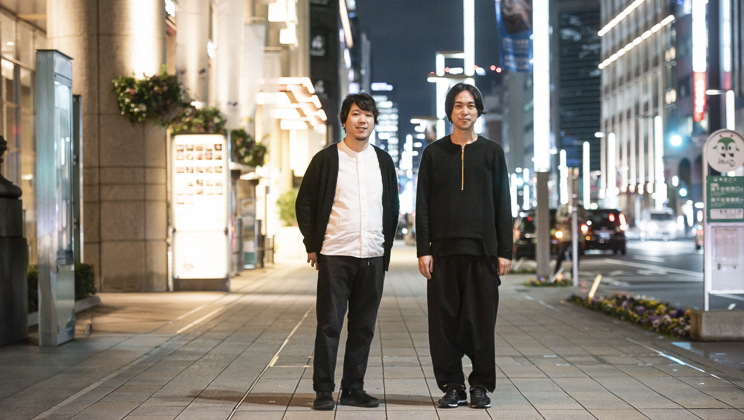

.jpg)
